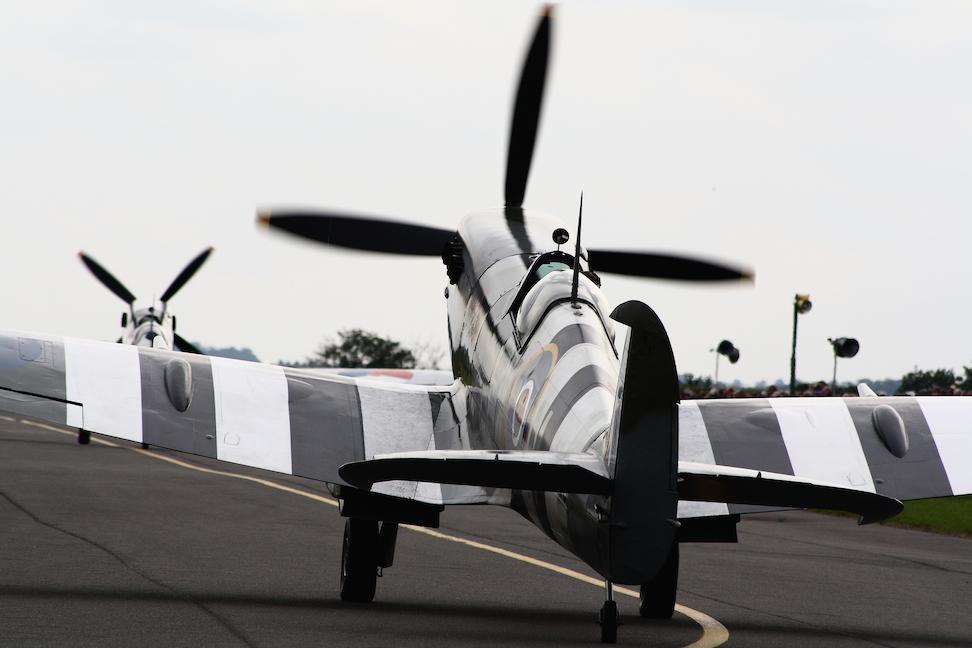In February 1940, the first N model, now known as the Typhoon, was delivered. Like the Tornado, the Typhoon was soon demonstrating its own problems, including vibrations from the engine causing the wing skinning to peel. The first production Mk IA was delivered in May 1941 with 12 Browning .303 guns, but this was followed quickly with the Mk IB with four Hispano 20 mm cannons.
By this time the Spitfire Vs were encountering the superior Focke-Wulf Fw 190 in combat and suffering heavy losses, with the inevitable result that the Typhoon was rushed into squadron service (with Nos. 56 and 609 Squadrons) to counter the new German plane. Sadly, this decision proved to be a disaster, and several Typhoons were lost for mysterious reasons. Once again there was talk of killing the Typhoon.
The cause of the tail failures was eventually identified only because one pilot managed to survive and return to tell his story. The problem was found to be caused by fatigue failure of the elevator mass-balance, allowing elevator-flutter to occur which was at its greatest when pulling out of a dive. Diving out of combat was the favourite escape manoeuvre for the Fw 190, which had a distinct speed advantage over the Spitfire. Against the Typhoon this manoeuvre should have proved deadly for the Fw pilots, but flutter problems turned the tables.
As a "temporary" measure, rectangular strengthening "fishplates" were riveted around the fuselage/empennage joint, the site of the failures. These fishplates remained a feature on all subsequent Typhoons. Problems with leakage of exhaust fumes into the cockpit and subsequent high carbon monoxide levels also meant Typhoon pilots had to use oxygen for even low level operations. The Sabre engine was also a constant source of problems, notably in colder weather where it was very difficult to start. During late 1942 and early 1943, the Typhoon Squadrons on the South Coast were finally effective in countering the Luftwaffe's "tip and run" low-level nuisance raids, shooting down a score or more fighter-bomber Fw 190s. The first two Messerschmitt Me 210 fighter-bombers to be destroyed over the British Isles fell to the guns of Typhoons in late 1942, and during a daylight raid by the Luftwaffe on London on 20 January 1943, five Fw 190s were destroyed by Typhoons.
As soon as the aircraft entered service it was immediately apparent the profile of the Typhoon resembled a Fw190 from some angles, and this similarity caused more than one "friendly fire" incident with Allied anti-aircraft units and other planes. This led to Typhoons being marked up with high visibility black and white stripes under the wings; a precursor of the marking applied to all Allied aircraft on D-Day.
The Typhoon would however become much more famous armed with four "60 lb" RP-3 rockets under each wing?the so-called "Rocketphoons." In October 1943, No. 181 Squadron made the first Typhoon rocket strikes. Although the rocket projectiles were inaccurate and took some considerable skill to aim properly and allow for the drop after firing, the sheer firepower of just one Typhoon was equivalent to a destroyer's broadside. The top speed of the Typhoon was reduced by some 15 mph by the non-jettisionable rocket rails. By the end of 1943, 18 rocket-equipped Typhoon squadrons formed the basis of the RAF's Second Tactical Air Force ground attack arm in Europe.
Inaccuracy notwithstanding, the rockets (backed by the Typhoon's four 20 mm cannon) proved highly effective against many targets, such as unarmoured "soft-skinned" vehicles, road transport, trains and small sea craft. Although great things were expected against the heavily armoured tanks of the Wehrmacht, the rockets needed to hit the thin-walled engine compartment or the tank's tracks to really have any destructive effect. Analysis of destroyed tanks after the Normandy battle showed a 'hit-rate' for the air-fired rockets of only 4%.
General characteristics
Crew: One
Length: 31 ft 11.5 in (9.73 m)
Wingspan: 41 ft 7 in (12.67 m)
Height: 15 ft 4 in (4.66 m)
Wing area: 249 ft² (23.13 m²)
Empty weight: 9,800 lb (4,445 kg)
Loaded weight: 11,400 lb (5,170 kg)
Max takeoff weight: 13,980 lb (6,340 kg)
Powerplant: 1× Napier Sabre IIC liquid-cooled H-24, 2,260 hp (1,685 kW)
Performance
Maximum speed: 405 mph at 18,000 ft (650 km/h at 5,485 m)
Range: 610 mi (980 km)
Service ceiling: 34,000 ft (10,400 m)
Rate of climb: 2,630 ft/min (13.4 m/s)
Wing loading: 45.8 lb/ft² (223.5 kg/m²)
Power/mass: 0.20 hp/lb (0.33 kW/kg)
Armament
4x 20 mm Hispano-Suiza HS.404 cannons
2x 1,000 lb (454 kg) bombs
8x 3 in (75 mm) RP-3 ("60 lb) unguided rockets

